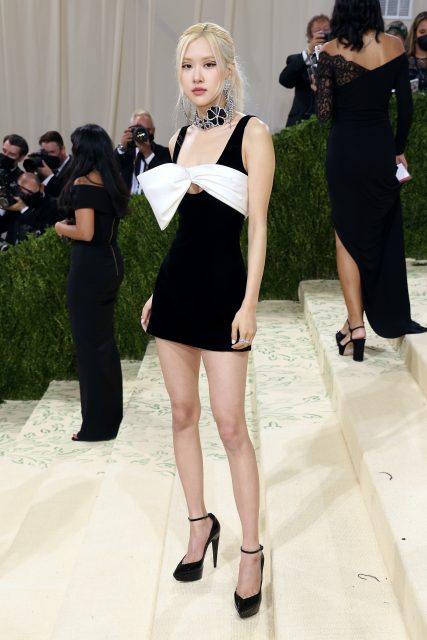An atmosphere of elation carried across the internet today as an unprecedented four young designers were announced as winners of this year’s LVMH Prizes at the Fondation Louis Vuitton in Paris. Nensi Dojaka—clearly overcome with astonishment—was finally called up to be awarded the €300,000 main 2021 title for her sexy-chic London-based collection after a tense half-hour delay in the live-streamed ceremony. The reason for that became clear. The LVMH jury—which includes Virgil Abloh, Jonathan Anderson, Maria Grazia Chiuri, Nicolas Ghesquière, Marc Jacobs, Kim Jones, and Stella McCartney—deliberating over a shortlist of nine designers from all over the world, had decided that a trio of talents, not one, should receive this year’s Karl Lagerfeld Prize. Colm Dillane of New York’s Kidsuper, Lukhanyo Mdingi,Lukhanyo Mdingi of Cape Town, and Rui Zhou for her Shanghai-based brand Rui learned that they’d each won €150,000 apiece.
“The designers were extremely strong and it was hard to choose,” said Delphine Arnault, who founded the prize for emerging designers in 2014. A pandemic later, everything has changed—the first stages of the selection process were carried out over Zoom and across social media, with a public vote included. The one thing it didn’t impact: the uplifting creativity and resilience of this new cohort of designers.
Arnault said it felt like a reunion for the creative directors of the LVMH houses (who haven’t got round one table for months on end) and something bigger: “After every moment that is tough—pandemic, wars—there’s always a lot of creativity. Christian Dior came after WWII, and those were very tough times,” she observed. The jury’s conversations with the contestants felt like a moment of coming “back to life—showing up for life.”
View this post on Instagram
With so much diversity and originality drawn into this year’s prize, what are the takeaways about the character of this 2021 generation? Hard to generalize, but amongst them there’s a distinct ability to focus, community-mindedness, and pure instinct for the delight in wearing clothes. Nensi Dojaka, who came to study in London from Albania at the age of 17, has put her finger on designing a sophisticated way of exposing and covering the body that’s become an immediate hit with young women raring to put lockdown schlump behind them. “I love female bodies, collarbones, the back. That’s why I do it. I had a dress that was selling a lot, everywhere—the little black dress that everyone had. Because we’re going out again.”
View this post on Instagram
Having shown under the umbrella of Lulu Kennedy’s Fashion East after graduating from Central Saint Martins MA—and receiving a crucial first degree in lingerie technology at London College of Fashion—one of her first customers was Bella Hadid, who wore a pair of her well-cut pants and a tulle-and-spaghetti strapped bodysuit to the VMAs last August, to instant Instagram sensation. Dojaka has her first stand-alone show in London Fashion Week next weekend. “I want to grow my team, perfect my production, and expand the offering for a wider public,” she told the jury.
Lukhanyo Mdingi, one of the three Karl Lagerfeld Prize winners, said “I’m just super-stoked to be Shari g this with two amazing designers. Mdingi follows Thebe Magugu as the second LVMH Prize winner from South Africa. “But what I do doesn’t necessarily pertain to South Africa,” he said. “I think if you look at Africa as a whole, there are different corners and pockets where there’s such a rich community of textile development and craft makers. We’re fortunate enough to have been able to work with people who have such finesse with what they do, who are based in Burkina Faso, as well as Kenya and South Africa. Being part of that brings a sense of honesty to our label, and I’m incredibly grateful to be in the presence of them.”
He shared a Zoom interview with Colm Dillane and Rui Zhou. Rui, who graduated from the Parsons MFA Fashion and Society Program, identifies her brand of curvaceous, finely-stranded cobwebby knits as “genderless, driven by bodies and embracing imperfection. I’m the first Chinese designer to get into the final,” she declared. “And I’m so excited by it.”
Last word to Dillane, whose exuberant Kidsuper menswear practice in New York is one of those category-defying up-shoots in art, clothing ,and localism that is actually becoming a defining characteristic of a new way of doing fashion. “Our three brains are astronomically different,” he said of his Lagerfeld prize fellows. “All of us have different stories, and the fact that we are here is incredible. From where I come from, from a streetwear perspective, it was always like: what can we get everyone to work towards, and how do the clothes encapsulate that? For me, they’re colorful, they’re joyful. The clothes are the merch that funds the community. It’s what pays for the Kidsuper space which has a recording studio, which people can live in and work out of, and do photoshoots and all that stuff,” he grinned. “So come to Brooklyn!”
Editor
Sarah MowerCredit
Lead Image: Courtesy of LVMH




